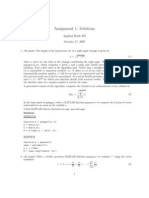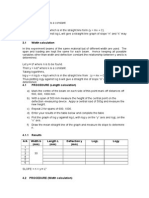0 ratings0% found this document useful (0 votes)
15 viewsGraphs of Logarithmic Functions
Uploaded by
api-103903160Copyright
© Attribution Non-Commercial (BY-NC)
Available Formats
Download as PDF, TXT or read online on Scribd
0 ratings0% found this document useful (0 votes)
15 viewsGraphs of Logarithmic Functions
Uploaded by
api-103903160Copyright
© Attribution Non-Commercial (BY-NC)
Available Formats
Download as PDF, TXT or read online on Scribd
You are on page 1/ 2
Using the logarithmic
function to find the points
on the line is based on two
rules, x cannot be negative
or equal to zero, therefore,
use only positive values
Example
If the function to giaph is:
y = !"#
!
!!!
Then the exponential
foim is:
! ! !
!
Possible values can be
determined using a table.
Make sure to also use
values for x that are
between 1 and 0.
** The graph will not
touch the y-axis
Graph of f(x) = !
!
Graph of f(x) =
!
!
!
Transforming the graph of a
logarithmic function is similar to
transforming function graphs
Example
The equation foi tiansfoimations is:
! ! ! ! ! !
! !!!
! !
4 variables control
the shift, stretch or
compression
a, c, h, k
!: stietches the function veitically by a "!#$%& %" (!(
#: stietches the function hoiizontally by a "!#$%& %" (
!
!
(
): *)+"$* the giaph )%&+,%-$!../
0: *)+"$* the giaph 12&$+#!../
If !34 the giaph is &2".2#$25 acioss the 67!6+*
If 839 the giaph is &2".2#$25 acioss the /7!6+*
Graph of f(x) =
!
!"!!
! !
1. Rewiite the function by taking out a factoi
of two in the exponent fiist: !
!!!!!!
! !
2. :25 ;+-2: giaph of f(x) = !
!
S. <.=2 ;+-2: k = 2, shifts the giaph up two
units
4. >&22- ;+-2: c = 2, change to |
!
!
| = V,
stietchs giaph by V anu becomes steepei
S. <.!#0 ;+-2: h = 1, shifts giaph one unit to
the iight
Domain and
Range
Bomain is always ?;; :@?; ABC<@:D: B = {All Real Numbeis}
Range uepenus on the veitical shift of the function:
f(x) = !
!
The asymptote is y = u, theiefoie the iange is:
R: {y > u}
f(x) = !
!
! !
The asymptote of the oiiginal functions is y =
u, it will shift up two, theiefoie:
R: {y > 2}
If the E&!F) +* &2".2#$25, the iange will
ieflect a *G+$#) +- $)2 +-2H=!.+$/ *+E-
f(x) = !
!
!!, R: {y >2}
f(x) = !!
!
!!, R: {y32}
f(x) = !
!
!!, R: {y >-2}
f(x) = !!
!
!!, R: {y3 72}
You might also like
- Transformations + Exponential FCT ReviewNo ratings yetTransformations + Exponential FCT Review9 pages
- Extension Questions Completing The SquareNo ratings yetExtension Questions Completing The Square1 page
- Programing in Matlab: General Rules of MatlabNo ratings yetPrograming in Matlab: General Rules of Matlab8 pages
- To Graph A Relation, We Need To Plot Each Given Ordered PairNo ratings yetTo Graph A Relation, We Need To Plot Each Given Ordered Pair11 pages
- Daniel Wahba - Optional Logarithmic AssigmentNo ratings yetDaniel Wahba - Optional Logarithmic Assigment6 pages
- Graph Transformations: Transformations "After" The Original FunctionNo ratings yetGraph Transformations: Transformations "After" The Original Function17 pages
- Graphing Exponential Functions: General MathematicsNo ratings yetGraphing Exponential Functions: General Mathematics38 pages
- Notes Topic 2.10 Key - Inverses of Exponential FunctionsNo ratings yetNotes Topic 2.10 Key - Inverses of Exponential Functions2 pages
- OperatorsAndExpressions (C Programming)No ratings yetOperatorsAndExpressions (C Programming)21 pages
- polynomial and rational functions slidesNo ratings yetpolynomial and rational functions slides91 pages
- V Best Chapter 1.1 Quadratics - ONLINE PDFNo ratings yetV Best Chapter 1.1 Quadratics - ONLINE PDF16 pages
- AP Calculus Flashcards, Fourth Edition: Up-to-Date Review and PracticeFrom EverandAP Calculus Flashcards, Fourth Edition: Up-to-Date Review and PracticeNo ratings yet
- Student Solutions Manual to Accompany Economic Dynamics in Discrete Time, secondeditionFrom EverandStudent Solutions Manual to Accompany Economic Dynamics in Discrete Time, secondedition4.5/5 (2)



























































